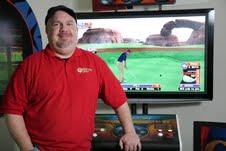Jim Zielinski, Video Game Designer
 Jim Zielinski
Jim ZielinskiJim Zielinski loves his job designing virtual golf courses. A good thing, too—he's been doing it for nearly half his life. "It's a lot of golf for 20 years, but it doesn't really get old," he said. "It's hard for me to think of anything I don't like."
The senior video game designer has worked for Incredible Technologies (IT) since 1988, when he was hired as a game tester. "Back then, IT was a very small company doing games for the Commodore 64," Zielinski recalled. "They started including some of my ideas while I was a tester, and I was given a chance to move into the design a few years later."
Now, he spends his days designing virtual golf courses for Golden Tee, IT's popular arcade game. In a recent interview, Zielinski shared a glimpse into his daily life and offered insider tips for budding video game designers.
A Day in the Life of a Video Game Designer
At the beginning of each year, Zielinski and his colleagues discuss how they plan to update Golden Tee and choose the geographical locations for the new courses. "After that, I'm pretty much given free rein to use my own creative skills to bring the elements of that location into the course," said Zielinksi.
His day-to-day work involves creating and working on the golf courses. "Today I'm working on a golf course that we're setting in Paris, France," said Zielinksi. "The sand traps are going to have a French design to them, a wrought-iron kind of look with curls, and are quite intricate. A lot of what I've been doing is making the sand traps and the hole look unique to Paris."
To translate his ideas into reality, Zielinksi relies on 3D Studio Max, a powerful program that allows him to render parametric and organic objects. He often imports his ideas and designs from Adobe Photoshop into 3D Studio Max.
For the game itself, IT uses proprietary hardware that was designed in-house. Zielinski typically creates golf holes on his personal computer and then exports them to the hardware platform, where he is able to play the holes and make further changes. "There are many iterations of each hole before it's finalized," he said.
Does it ever get boring? On the contrary, said Zielinski. "I really love being able to sit down with a blank piece of paper, and whatever I come up with out of my head is eventually going to become part of Golden Tee. It's a great creative outlet."
Two Career Paths to Becoming a Video Game Designer
Zielinski described two main routes for becoming a video game designer. The first approach is to follow in Zielinski's footsteps: start as a game tester and work your way up. "There's still a lot of demand for game testers," he said. "It's not a bad way to get into the industry from the ground up."
Testing video games all day may appeal to you, but Zielinski said it's not as glamorous as it sounds. "You're not really playing the game to have fun," he explained. "You're playing the game to break it, so you're doing the same thing over and over again, trying to make it fail."
If you're interested in becoming a game tester, you don't need any formal qualifications. Just find a company that develops video games in your area and apply. A good candidate will have strong organizational skills and excellent attention to detail. "The smallest of things can cause a game to break," Zielinski said, "and you need to hone in on exactly where the stuff happens."
Good communication skills are critical for a game tester who wants to move into designing. As a tester, you'll interact very closely with designers. Take advantage of the close relationship to share your creative ideas. "Put them on paper, let people know about them," Zielinksi said. "It doesn't matter if it's implemented or not. Sometimes, a part of an idea can spark something else."
The second approach to becoming a game designer is more direct. "If I was going to suggest to someone what career path to take, I'd say get a computer science degree," Zielinski said. "You're going to procure a job much more easily with a computer science degree than you are maybe working your way up from the bottom as a tester."
Not only does a computer science degree make you more marketable, but your technical expertise helps you see the big picture. "It's a big advantage, because you know exactly what's possible, you know technically whether things can be done or not," Zielinski said.
The Future of Video Game Design
Zielinski recalled how Golden Tee's success came about during the early days of the internet. "Our tournament system allowed all of our coin op machines to communicate with our central server," he said. "We were ahead of the game, nobody else in the industry was doing what we were doing. The ability to play a guy around the country and compete against him was pretty cool at the time."
Now that every home computer is connected to the internet, Golden Tee is pushing the envelope in other ways. Emerging communication technologies will play a key role in video game development. "Every year the technology gets a little better," said Zielinski. "For example, the last couple years we've gone into high definition. Our earlier cabinets were typical stand-alone cabinets that you'd see in a bar or arcade. Now what we have is a little pedestal in front of a large high definition TV. I think as things develop on the consumer end, we're going to bring those new technologies to our audience."